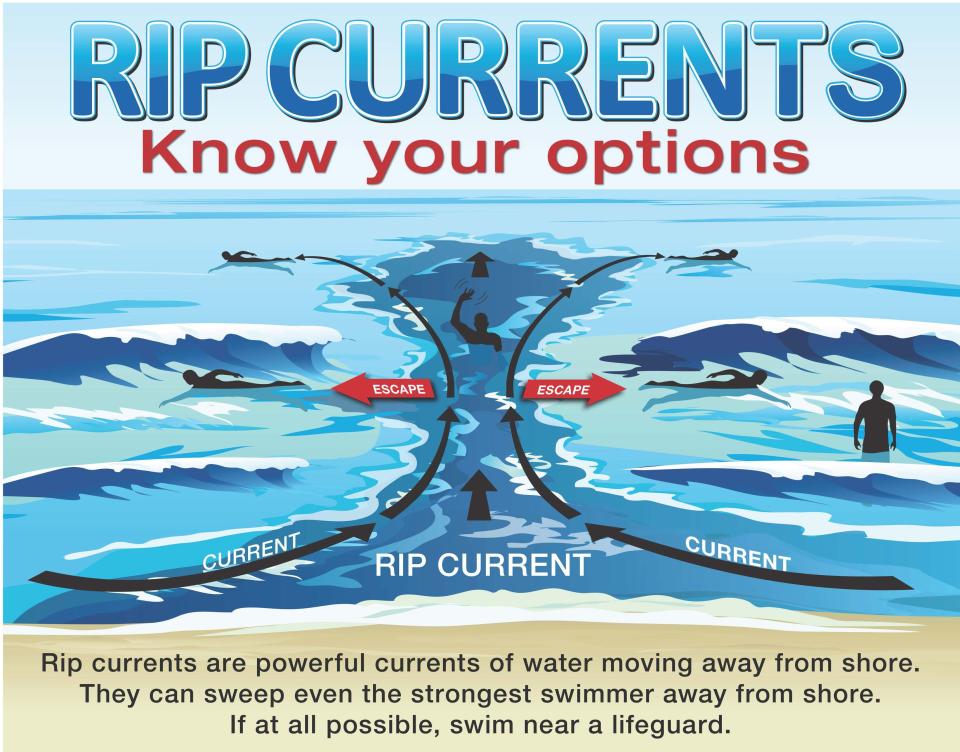Can you spot a rip current? Here are 5 tips to practice the next time you're at the beach
Despite increasing campaigns to raise awareness and educate beachgoers on the dangers, rip current deaths in Panama City Beach reached a grim milestone after the total number of drownings reached seven last week.
In response to the recent drownings, Panama City Beach Police Chief JR Talamantez announced that between one and three officers will now be assigned to patrol the city's coast during double-red-flag conditions to prevent beachgoers from entering the Gulf of Mexico.
In six of the seven drownings, single red flags were displayed along the coast, a warning indicating that swimmers should stay out of the water due to dangerous conditions. The seventh drowning occurred off a beach in unincorporated Bay County.
Fatal vacations: A look at the 7 tourists who have drowned in Bay County so far this year
Even with an increase in police presence, the best way to protect yourself and your family from rip currents is through education. Rip currents can be tough to spot, but learning the signs to look for could make all the difference. Here's what to know.
Beach safety tips
Here are some safety tips to help make any beach trip safe.
Always swim where lifeguards are present – Swimming where you can see lifeguards on duty is an easy way to ensure that you’re in a safe spot, even if you get swept up in a current you might not have spotted.
Pay attention to Florida’s flag system – Dangerous conditions aren’t always apparent, especially to people with limited experience. It’s important to check the beach’s current conditions before heading into the water. You can typically check online or look for flags posted around the beach.
Be wary of rip currents – Rip currents are dangerous, narrow channels of water that flow past the surf zone. These currents can pull even strong swimmers into deep water beyond the offshore sandbar. You can find more information on how to spot a rip current below.
How to spot a rip current

Spotting a rip current is no easy task, but it can be done with practice once you know what you’re looking for. Here are some tips:
If you happen to find yourself in an elevated spot before heading to the beach, take a look at the water ahead of time. It’s much easier to see rip currents from an elevated position. There are often beachfront restaurants and businesses with elevated views, and some beach access points will give you a good look.
Look for gaps or “calm” spots in between waves, or places where the waves aren’t breaking. These spots can be hotbeds for rip currents due to the water rushing back into the ocean rather than toward the shore.
Avoid spots with lots of sandy clouds, seaweed and other debris. These can be indicators of rip currents carving out sand and other debris and washing them back out toward the ocean.
Similarly, be on the lookout for dark spots in the water. This can be further evidence that a rip current is present.
A spot with a rippled surface surrounded by smooth water could be an effect of rip currents. In this case, various currents heading in different directions are pushing together.
What is a rip current?
Rip currents are powerful, concentrated channels of water flowing quickly away from shore, most often found at low spots or breaks in the sandbar and near structures such as jetties and piers.
Rip currents form when incoming waves create an underwater sandbar. The waves push more water between the sandbar and the shore until it collapses and the water rushes back to the sea through a narrow gap, where it starts to spread out. But they can be difficult to see when you're in the water as the ocean over them can still be smooth.
Rip currents often form during or after stormy weather but can form on bright, sunny days just as easily since the weather isn't really what's causing them. Rip currents can be found at any beach with waves, at any time.
Can you swim away from a rip current?

While you're in it, it can feel relentless.
Even strong, experienced swimmers caught in a rip current can easily tire themselves out trying to swim back to shore against a rip current.
This article originally appeared on Pensacola News Journal: Rip current deaths rise. Can you spot one before its too late?

